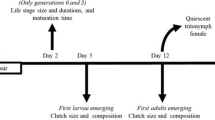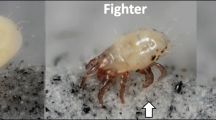Abstract
Understanding the evolution and maintenance of within-sex reproductive morphs, or alternative reproductive phenotypes (ARPs), requires in depth understanding of the proximate mechanisms that determine ARP expression. Most species express ARPs in complex ecological environments, yet little is know about how different environmental variables collectively affect ARP expression. Here, I investigated the influence of maternal and developmental nutrition and sire phenotype on ARP expression in bulb mites (Rhizoglyphus robini), where males are either fighters, able to kill other mites, or benign scramblers. In a factorial experiment, females were raised on a rich or a poor diet, and after maturation they were paired to a fighter or a scrambler. Their offspring were put on the rich or poor diet. Females on the rich diet increased investment into eggs when mated to a fighter, but suffered reduced longevity. Females indirectly affected offspring ARP expression as larger eggs developed into larger final instars, which were more likely to develop into a fighter. Final instar size, which also strongly depended on offspring nutrition, was the main cue for morph development: a switch point, or size threshold, existed where development switched from one phenotype to the other. Sire phenotype affected offspring phenotype, but only if offspring were on the poor diet, indicating a gene by environment interaction. Overall, the results revealed that complex environmental effects can underlie ARP expression, with differential maternal investment potentially amplifying genetic effects on offspring morphology. These effects can therefore play an important role in understanding how selection affects ARP expression and, like quantitative genetics models for continuous traits, should be incorporated into models of threshold traits.




Similar content being viewed by others
References
Baayen RH, Davidson DJ, Bates DM (2008) Mixed-effects modeling with crossed random effects for subjects and items. J Mem Lang 59:390–412
Bashey F (2006) Cross-generational environmental effects and the evolution of offspring size in the Trinidadian guppy Poecilia reticulata. Ecology 60:348–361
Bates D, Sarkar D (2007) lme4: linear mixed-effects models using S4 classes. R package version 0.9975-13
Benton TG, Plaistow SJ, Beckerman AP et al (2005) Changes in maternal investment in eggs can affect population dynamics. Proc R Soc Lond B 272:1351–1356
Brockmann HJ, Taborsky M (2008) Alternative reproductive tactics and the evolution of alternative allocation phenotypes. In: Oliveira RF, Taborsky M, Brockmann HJ (eds) Alternative reproductive tactics. Cambridge University Press, Cambridge, pp 25–51
Brockmann HJ, Oliveira RF, Taborsky M (2008) In: Oliveira RF, Taborsky M, Brockmann HJ (eds) Alternative reproductive tactics. Cambridge University Press, Cambridge, pp 471–489
Brody MS, Lawlor LR (1984) Adaptive variation in offspring size in the terrestrial isopod, Armadillidium vulgare. Oecologia 61:55–59
Burley N (1986) Sexual selection for aesthetic traits in species with biparental care. Am Nat 127:415–445
Cohen J (1988) Statistical power analysis for the behavioral sciences. Erlbaum, Hillsdale
Coulson T, Tuljapurkar S, Childs DZ (2010) Using evolutionary demography to link life history theory, quantitative genetics and population ecology. J Anim Ecol 79:1226–1240
Cunningham EJ, Russell AF (2000) Egg investment is influenced by male attractiveness in the mallard. Nature 404:74–77
Day T, Rowe L (2002) Developmental thresholds and the evolution of reaction norms for age and size at life-history transitions. Am Nat 159:338–350
Eberhard WG, Gutiérrez EE (1991) Male dimorphisms in beetles and earwigs and the question of developmental constraints. Evolution 45:18–28
Emlen DJ (1994) Environmental control of horn length dimorphism in the beetle Onthophagus acuminatus (Coleoptera, Scarabaeidae). Proc R Soc Lond B 256:131–136
Emlen DJ (2008) The roles of genes and the environment in the expression and evolution of alternative tactics. In: Oliveira RF, Taborsky M, Brockmann HJ (eds) Alternative reproductive tactics. Cambridge University Press, Cambridge, pp 83–108
Falconer DS (1989) Introduction to quantitative genetics, 3rd edn. Wiley, New York
Falconer DS, Mackay TFC (1996) Introduction to quantitative genetics, 4th edn. Pearson Education Ltd, Harlow
Fox CW, Czesak ME (2000) Evolutionary ecology of progeny size in arthropods. Annu Rev Entomol 45:341–369
Fox CW, Thakar MS, Mousseau TA (1997) Egg size plasticity in a seed beetle: an adaptive maternal effect. Am Nat 149:149–163
Gerson U, Capua S, Thorens D (1983) Life history and life tables of Rhizoglyphus robini Claparède (Acari: Astigmata: Acaridae). Acarologia 24:439–448
Gerson U, Cohen E, Capua S (1991) Bulb mite, Rhizglyphus robini (Astigmata: Acaridae) as an experimental animal. Exp Appl Acarol 12:103–110
Gil D, Graves J, Hazon N et al (1999) Male attractiveness and differential testosterone investment in zebra finch eggs. Science 286:126–128
Hazel WN, Smock R, Johnson MD (1990) A polygenic model for the evolution and maintenance of conditional strategies. Proc R Soc Lond B 242:181–187
Hazel WN, Smock R, Lively CM (2004) The ecological genetics of conditional strategies. Am Nat 163:888–900
Hunt J, Simmons LW (2000) Maternal and paternal effects on offspring phenotype in the dung beetle Onthophagus taurus. Evolution 54:936–941
Hunt J, Simmons LW (2001) Status-dependent selection in the dimorphic beetle Onthophagus taurus. Proc R Soc Lond B 268:2409–2414
Kirkpatrick LM, Lande R (1989) The evolution of maternal characters. Evolution 43:485–503
Kolm N (2001) Females produce larger eggs for large males in a paternal mouthbrooding fish. Proc R Soc Lond B 268:2229–2234
Kotiaho JS, Simmons LW, Hunt J et al (2003) Males influence maternal effects that promote sexual selection: a quantitative genetic experiment with dung beetles Onthophagus taurus. Am Nat 161:852–859
Kruuk LEB (2004) Estimating genetic parameters in wild populations using the ‘animal model’. Philos Trans R Soc Lond B 359:873–890
Michimae H, Nishimura K, Tamori Y, Wakahara M (2009) Maternal effects on phenotypic plasticity in larvae of the salamander Hynobius retardatus. Oecologia 160:601–608
Mousseau TA, Fox CW (1998) Maternal effects as adaptations. Oxford University Press, Oxford
Oliveira RF, Taborsky M, Brockmann HJ (eds) (2008) Alternative reproductive tactics. Cambridge University Press, Cambridge
Plummer M, Best N, Cowles K et al. (2006) Coda: output analysis and diagnostics for MCMC. R package version 0.10-7
Radwan J (1993) The adaptive significance of male polymorphism in the acarid mite Caloglyphus berlesei. Behav Ecol Sociobiol 33:201–208
Radwan J (1995) Male morph determination in 2 species of acarid mites. Heredity 74:669–673
Radwan J (2001) Male morph determination in Rhizoglyphus echinopus. Exp Appl Acarol 25:143–149
Radwan J (2003) Heritability of male morph in the bulb mite, Rhizoglyphus robini (Astigmata, Acaridae). Exp Appl Acarol 29:109–114
Radwan J (2009) Alternative mating tactics in acarid mites. Adv Stud Behav 39:185–208
Radwan J, Klimas M (2001) Male dimorphism in the bulb mite, Rhizoglyphus robini: fighters survive better. Ethol Ecol Evol 12:69–79
Radwan J, Czyż M, Konior M et al (2000) Aggressiveness in two male morphs of the bulb mite Rhizoglyphus robini. Ethology 106:53–62
Radwan J, Unrug J, Tomkins JL (2002) Status-dependence and morphological trade-offs in the expression of a sexually selected character in the mite, Sancassania berlesei. J Evol Biol 15:744–752
Radwan J, Unrug J, Śnigórska K et al (2004) Effectiveness of sexual selection in preventing fitness deterioration in bulb mite populations under relaxed natural selection. J Evol Biol 17:94–99
Repka J, Gross MR (1995) The evolutionarily stable strategy under individual condition and tactic frequency. J Theor Biol 176:27–31
Ryan MJ, Pease CM, Morris MR (1992) A genetic polymorphism in the swordtail Xiphophorus nigrensis. Testing the prediction of equal fitnesses. Am Nat 139:21–31
Schlichting CD, Pigliucci M (1995) Gene regulation, quantitative genetics and the evolution of reaction norms. Evol Ecol 9:154–168
Sheldon B (2000) Differential allocation: tests, mechanisms and implications. Trends Ecol Evol 15:397–402
Shuster SM, Wade MJ (1991) Equal mating success among male reproductive strategies in a marine isopod. Nature 350:608–610
Shuster S, Wade MJ (2003) Mating systems and strategies. Princeton University Press, Princeton
Smallegange IM, Coulson T (in press) The stochastic demography of two coexisting male morphs. Ecology
Tomkins JL, Hazel W (2007) The status of the conditional evolutionarily stable strategy. Trends Ecol Evol 22:522–528
Tomkins JL, LeBas NR, Unrug J et al (2004) Testing the status-dependent ESS model: population variation in fighter expression in the mite Sancassania berlesei. J Evol Biol 17:1377–1388
Wedell N (1996) Mate quality affects reproductive effort in a paternally investing species. Am Nat 148:1075–1088
Williams GC (1966) Adaptation and natural selection. Princeton University Press, Princeton
Acknowledgments
I thank Tim Coulson and Mark Roberts for discussion and comments, and The Netherlands Organisation for Scientific Research for funding (Rubicon Fellowship). All experimental work conducted in this study conforms to the legal requirements of the UK.
Author information
Authors and Affiliations
Corresponding author
Electronic supplementary material
Below is the link to the electronic supplementary material.
Rights and permissions
About this article
Cite this article
Smallegange, I.M. Complex environmental effects on the expression of alternative reproductive phenotypes in the bulb mite. Evol Ecol 25, 857–873 (2011). https://doi.org/10.1007/s10682-010-9446-6
Received:
Accepted:
Published:
Issue Date:
DOI: https://doi.org/10.1007/s10682-010-9446-6




